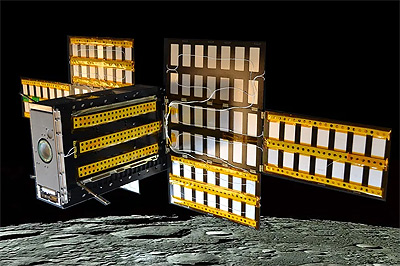Thank you very much for visiting Gunter's Space Page. I hope that this site is useful and informative for you.
If you appreciate the information provided on this site, please consider supporting my work by making a simple and secure donation via PayPal. Please help to run the website and keep everything free of charge. Thank you very much.
LunaH-Map (SIMPLEx 1)

LunaH-Map [Arizona State University]
LunaH-Map (Lunar Polar Hydrogen Mapper) is 6U-Cubesat mission to map lunar near-surface hydrogen (H).
Lunar polar Hydrogen Mapper (LunaH-Map) is a 6U cubesat that will enter a polar orbit around the Moon with a low altitude (5 - 12 km) perilune centered on the lunar South Pole.
LunaH-Map will:
- map H within permanently shadowed craters to determine its spatial distribution;
- map H distributions with depth (< 1 meter); and
- map the distribution of H in other permanently shadowed regions (PSRs) throughout the South Pole.
LunaH-Map will carry two neutron spectrometers that will produce maps of near-surface hydrogen (H) at unprecedented spatial scales (~7.5 km/pixel).
LunaH-Map CubeSat will be developed at Arizona State University, utilizing the facilities in the Space and Terrestrial Robotic Exploration (SpaceTREx) Laboratory at Arizona State University in partner ship with NASA's Jet Propulsion Laboratory and a variety of other commercial providers supplying space-qualified hardware. Onboard propulsion will provide δV sufficient for lunar orbit insertion (LOI), all orbital maneuvers and station keeping throughout the science phase of the mission. Solar panels will generate 30 W of power. Attitude control consists of a set of 3-axis Sinclair reaction wheels. Communications use IRIS 3 X-band of MarCO heritage combined with Doppler for spacecraft tracking. LunaH-Map will also include a wide-angle engineering camera system for outreach and non-essential engineering images.
LunaH-Map is one of 10 cubesats carried with the Artemis 1 (Orion CM-002) mission into a heliocentric orbit in cis-lunar space on the maiden flight of the SLS (Block 1) iCPS launch vehicle in November 2022.
| Nation: | USA |
|---|---|
| Type / Application: | Lunar orbiter |
| Operator: | NASA Jet Propulsion Laboratory |
| Contractors: | NASA Jet Propulsion Laboratory |
| Equipment: | |
| Configuration: | CubeSat (6U) |
| Propulsion: | BIT-3 thruster |
| Power: | 4 deployable solar arrays, batteries |
| Lifetime: | < 2 years |
| Mass: | ~14 kg |
| Orbit: | Lunar orbit |
| Satellite | COSPAR | Date | LS | Launch Vehicle | Remarks | |
|---|---|---|---|---|---|---|
| LunaH-Map (SIMPLEx 1) | 2022-156J | 16.11.2022 | CCK LC-39B | SLS (Block 1) iCPS | with Artemis 1 (Orion CM-002), BioSentinel, CuSP, Lunar-IceCube, NEA-Scout, LunIR, EQUULEUS, OMOTENASHI, ArgoMoon, Miles |
References:
- Craig Hardgrove, Jim Bell et al.: The Lunar Polar Hydrogen Mapper (LunaH-Map) Mission – Mapping Hydrogen Distributions In Permanently Shadowed Regions Of The Moon’s South Pole, Lunar Exploration Analysis Group, 2015
- Craig Hardgrove, Jim Bell et al.: LunaH-Map CubeSat, 2015
